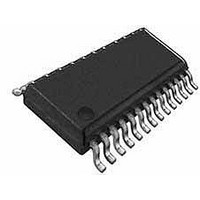WM8731SEDS/V Wolfson Microelectronics, WM8731SEDS/V Datasheet - Page 48

WM8731SEDS/V
Manufacturer Part Number
WM8731SEDS/V
Description
Audio CODECs Stereo Codec with H/P
Manufacturer
Wolfson Microelectronics
Datasheet
1.WM8731LSEFLR.pdf
(64 pages)
Specifications of WM8731SEDS/V
Interface Type
Serial (2-Wire or 3-Wire), I2S
Resolution
24 bit
Operating Supply Voltage
2.7 V to 3.6 V
Maximum Operating Temperature
+ 85 C
Mounting Style
SMD/SMT
Package / Case
SSOP-28
Minimum Operating Temperature
- 40 C
Number Of Channels
2 ADC / 2 DAC
Snr
90 dB
Thd Plus Noise
- 84 dB
Lead Free Status / RoHS Status
Lead free / RoHS Compliant
WM8731 / WM8731L
w
MICPD: Simultaneously powers down both the Microphone Input and Microphone Bias. If this is done
dynamically, audible pops through the ADC will result. This will only be audible if the Microphone
Input is selected to the ADC at the time. If the state of MICPD is changed then the controlling DSP or
microprocessor should switch to select the Line Inputs as input to the ADC (INSEL) before changing
MICPD. This is of use when the device enters Playback, Pause or Stop modes or the Microphone
Input is not selected.
ADCPD: Powers down the ADC and ADC Filters. If this is done dynamically then audible pops will
result if any signals were present through the ADC. To overcome this whenever the ADC is to be
powered down, either mute the Microphone Input (MUTEIN) or MUTELINEIN, then change ADCPD.
This is of use when the device enters Playback, Pause or Stop modes regardless of whether
Microphone or Line Inputs are selected.
DACPD: Powers down the DAC and DAC Digital Filters. If this is done dynamically then audible pops
will result unless the following guidelines are followed. In order to prevent pops, the DAC should first
be soft-muted (DACMU), the output should then be de-selected from the line and headphone output
(DACSEL), then the DAC powered down (DACPD). This is of use when the device enters Record,
Pause, Stop or Bypass modes.
OUTPD: Powers down the Line and Headphone outputs. If this is done dynamically then audible
pops may result unless the DAC is first soft-muted (DACMU). This is of use when the device enters
Record, Pause or Stop modes.
OSCPD: Powers off the on board crystal oscillator. The MCLK input will function independently of the
Oscillator being powered down.
CLKOUTPD: Powers down the CLOCKOUT pin. This conserves power, reduces digital noise and RF
emissions if not required. CLKOUT is tied low when powered down.
The device can be put into a standby mode (STANDBY) by powering down all the audio circuitry
under software control as shown in Table 27. If the crystal oscillator and/or CLOKOUT pins are being
used to derive the system master clock, these should probably never be powered off in standby.
Provision has been made to independently power off these areas according to Table 27.
Table 27 Standby Mode
In STANDBY mode the Control Interface, a small portion of the digital and areas of the analogue
circuitry remain active. The active analogue includes the analogue VMID reference so that the
analogue line inputs, line outputs and headphone outputs remain biased to VMID. This reduces any
audible effects caused by DC glitches when entering or leaving STANDBY mode.
0
0
0
0
1
1
0
0
1
1
1
1
1
1
1
1
1
1
1
1
1
1
1
1
DESCRIPTION
STANDBY, but with Crystal
Oscillator OS and CLKOUT
available
STANDBY, but with Crystal
Oscillator OS available,
CLKOUT not-available
STANDBY, Crystal
oscillator and CLKOUT not-
available.
PD, Rev 4.8, April 2009
Production Data
48











